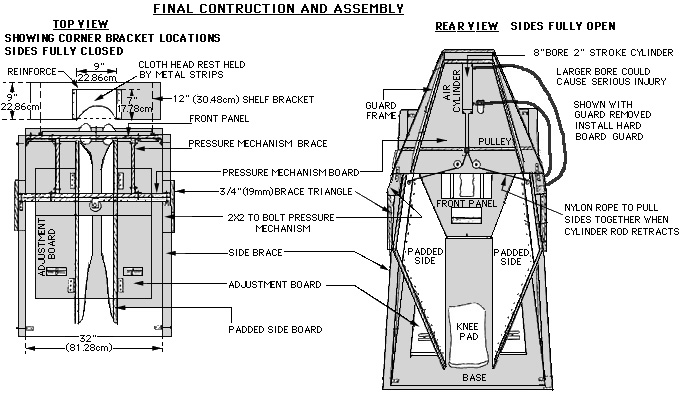
Dr. Temple Grandin designed the original hug machine, a device which effectively treats autism by providing deep touch stimulation to the user. However, with a minimum cost of $4,400, weight of 350 pounds and its large size.
The original hug machine as developed by Dr. Temple Grandin is the only current model known to exist. It consists of two padded side boards which connected at their bottoms with hinges to a single base, forming a V-shape
between them. To use the device, one lies on their knees and elbows in the prone position inside the V-shaped cavity. The tops of the side boards are connected to a pneumatic valve, which is in turn connected to an air cylinder, and during use this configuration squeezes the sides together. The amount of pressure is determined by the user, who has complete control over a lever that regulates the force applied with smooth transitions between settings. Thus, by the nature of the design, the user’s body is supported from head to toe as the sides squeeze together, applying an inward force creating lateral deep touch pressure stimulation.
The padding on the side boards is contoured, providing even pressure along the lateral aspects of the body and removing specific pressure points. In this way, large amounts of pressure can be delivered over large areas of the body without causing safety concerns to the user. In addition, there is a foam-padded headrest attached to the device near a padded opening for the user’s neck, both of which enhance the therapy provided by furthering the feeling of being surrounded and contained.

Newser) – Temple Grandin, the renowned animal behaviorist who credits her achievements to her autism, values "tangible results" over emotion—and so does her HBO biopic. The eponymous film, debuting tomorrow, "avoids the mawkish clichés" so typical of made-for-TV movies, instead delivering "a movie that is funny, instructive, and also intangibly charming," writes Alessandra Stanley in the New York Times.
Grandin is famous for designing humane slaughterhouses, and the film combines "a wonderstruck look at feedlots and loading ramps and a practical, pragmatic view of autism." Claire Danes, in the title role, "is completely at ease in her subject’s lumbering gait and unmodulated voice. She makes Temple’s anxiety as immediate and contagious as her rarer bursts of merriment. And as the character ages and learns more social graces, Ms. Danes seamlessly captures Temple’s progress."

